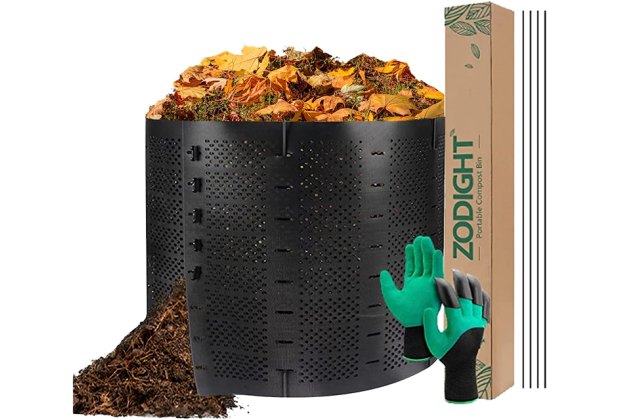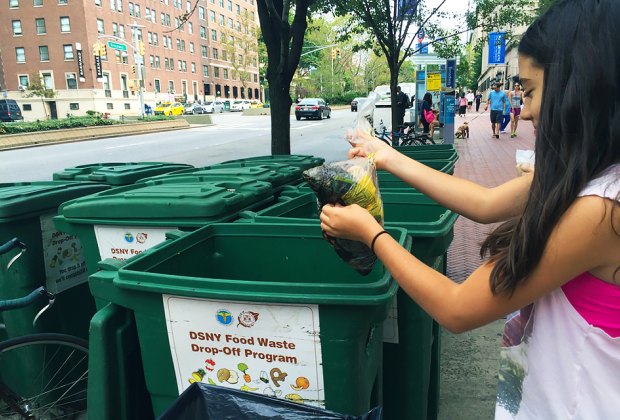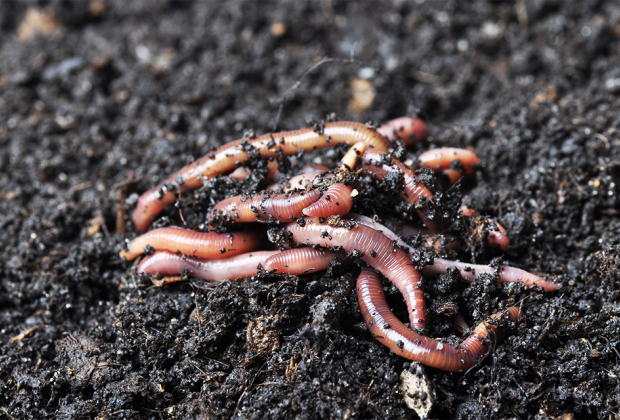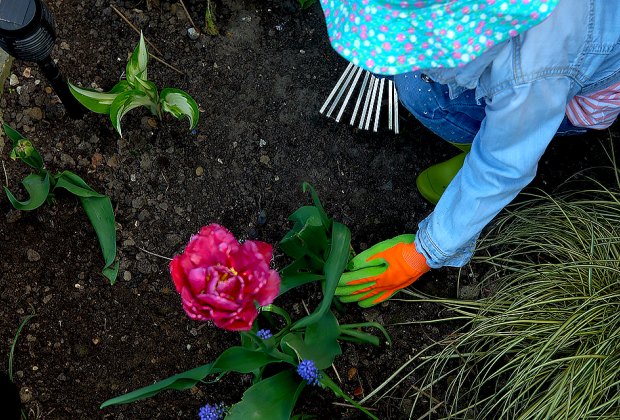Everything about how to compost sounds like a recipe for disaster: it takes up loads of space, it's super smelly, and everyone knows it attracts mice. Throw kids into the mix, and what parent wants to start that project? Unless ... none of that conventional wisdom is actually true. Composting is clean, stink-and-critter-free, reduces landfill, is great for the earth, and is a task that kids are eager to take on. Ok, mostly critter-free. If you have a backyard, you might want to get some worms—but for your kids, that will be part of the appeal!
Many cities, including New York and Los Angeles, offer composting programs where residents have a separate bin for organic waste. Other cities have private organizations with receptacles in designated locations for compost. But you can also compost in your own yard or kitchen, and with these easy steps to get started, your kids can be a part of the process.
For 26 Tips for Living More Sustainably Every Day and more ideas for creating more earth-friendly habits for your family, check out our Earth Kids Guide and sign up for our Earth Kids newsletter for more ideas and activities every month.
Latest Videos
Connatix video player

There are all kinds of ways of composting, from a garden bin to a kitchen container. Photo by Joi, CC BY 2.0
1. Pick the perfect spot
If you have a yard, find a dry, shady place for your bin or pile. You'll also need access to a water source, so choose a spot that your hose can reach, or where you can easily carry a watering can from the tap. Kids can help by checking where the shadows are and if your hose will reach this far.
If you live in an apartment or don't have the space (or inclination!) to compost in the yard, but instead will donate your compostables to the city or a local garden, it's even easier. You'll just need a kitchen composter. In fact, you'll need one of these regardless, as you'll want the ease of collecting banana peels and eggshells right in the kitchen, not heading out to your backyard bin every time you need to scrape dinner plates.
Once you know where you're composting, it's time to get your gear.
RELATED: 17 Tricks For How Kids Can Conserve Water

The Zodight is a great compost bin for families just getting started. Photo courtesy of the manufacturer
2. Go shopping
Since everyone will need a kitchen composter, that's a perfect place to start. They can be as little as half a gallon up to about five gallons. You can even find one that tucks neatly under your kitchen sink, hanging on the back of a cabinet. Lack of space is no excuse not to compost! You can even compost in a paper bag, although you might want to do this in a garage or on a balcony to keep bugs that can get into a non-secured container outside of your living area. Kids can help select a good spot for the composter, close to where you usually put your garbage, and pick out a good-looking container.
If you're composting in your yard, you'll also need a backyard composting bin that you empty your kitchen container into every few days. If you're just getting started, consider an adjustable-size composter like this one from Zodight. Or you can pick a compost tumbler that makes it easier to stir up your compost, like this from Miracle-Gro.
3. Name your compost bin
Have your kids pick out a name for your compost bin. Why? Your compost needs to be fed; it's a hungry monster. When it has a name it makes it more fun to feed, and makes the concept of what goes into the compost bin more silly and accessible for kids. That way, instead of saying, "throw that in the compost bin" you can tell your kids to "feed Seymour." (That's what we called our first bin, inspired by Audrey in Little Shop of Horrors saying "Feed me, Seymour!") Seymour loves apple cores, but hates chicken bones. What else does your bin like to eat?
mediumrectangle-inline
mediumrectangle-inline
RELATED: 12 Recycled Crafts for Kids

If you don't want a backyard bin, you can drop your compost at locations around your city. Photo courtesy Cafeteriaculture.org
4. Feed your compost monster
Compost piles are made up of "brown" carbon-rich materials, like dead leaves, sticks, and pine needles, "green" nitrogen-rich materials like fruit and veggie scraps, coffee grounds, and grass clippings, "black" material (aka dirt), and water. Not sure what you can compost? We made a fun game of asking our smart speaker if we can compost different things. Hair from your hairbrush? Yep. Eggshells? Sure. Kitty litter? Nope. Bacon grease? Nah. As a general rule, things that come from a plant are okay, but most animal products are a no-go because they attract rodents or slow down decomposition. The exceptions are eggshells, hair, fur, and nail clippings. Also, remember that paper comes from plants, so things like coffee filters can go in the pile. Just avoid anything with a glossy finish like magazines—those won't decompose. And don't add too much paper; that's what blue recycle bins are for!
Also, make sure you leave out any diseased plants or plants that have gone to seed. Those will just spread disease or seeds into the pile.
Don't forget to feed lunch leftovers to your compost! When packing a zero-waste lunch for kids, an important part of that is reminding them to bring home the things they don't eat. Have kids help you unpack their lunchboxes and feed your compost bin the food they didn't eat.
Now, if you're adding your compost to your backyard bin, proceed to Step 5. If, however, your family is kitchen composting, and then emptying your kitchen compost into a city compost bin or donating it to a local garden, you're all set! Congratulations, you've helped reduce landfill and contributed to a healthier world. Call your local city sanitation department, and ask them for a compost bin that will be collected, or for a list of locations in your city where you can donate your compost. There may even be a community garden right near you.
RELATED: Backyard Gardening With Kids
mediumrectangle-inline
mediumrectangle-inline

Layer your compost pile; it ends up looking gorgeous! Photo by Edward Howell
5. Build your compost pile
It's time to build your pile. Set up your bin or any fencing that will go around the pile. Then add six inches of brown materials—leaves are probably the easiest. Kids already love raking leaves, so rake 'em up, jump in them a few times, then put them into the bin. Sprinkle this layer with water. Next, add the green materials—grass clippings are easy to get in a high volume if you have a bigger yard or work on building up a week or more of coffee grounds and leftover food scraps. Chop up your food bits into little pieces to help them decompose faster. Kids may enjoy tearing up fruit peels, curling carrot bits, or ripping lettuce that has passed its prime to create a layer of nitrogen-based materials. Add enough water to get everything just a little wet. Shovel in some dirt to top it off, and then water the dirt.
Repeat the layers until your composting container is full. Kids can think of it like building a giant dirt lasagna or parfait.
RELATED: How to Grow an Indoor Herb or Vegetable Garden

Earthworms are beloved by compost and kids!
7. Add time (and worms)
Now that your pile is built, you have to wait for the materials to decompose into rich soil. About once a week, you should turn or stir your pile to incorporate the "ingredients" together using a rake or trowel. Kids should be able to see how the distinct layers start melding into a more uniform composition. You should see some fun bugs, like roly-polys, earthworms, and millipedes, working their way into the compost to help the process along. Don't see any bugs? You can get some earthworms online or at your local pet or garden store, and add them to the mix. (Quick tip: don't add earthworms to your compost bin if it's a tumbler; these get too hot for earthworms to thrive.)
8. Let's talk mice
This isn't a step, but it's one of the most important concerns people have that stops many families from composting: the dreaded critter question. Will composting draw mice and rats to your yard? Only if you want them! If you have an airtight compost bin and turn it regularly, or use a tumbler, you won't be creating an environment where mice or other mammals can live. Mice and rats are attracted to warm piles filled with food, so if you just have a compost pile in a corner of your yard, it could attract critters—some people don't mind and think that feeding the mice outside will keep them from wanting to sneak into your house to look for warmth and food. But if you don't want mice in your compost, simply purchase an airtight container, which is impossible for them to penetrate.
mediumrectangle-inline
mediumrectangle-inline
9. Time to buy a pitchfork!
Want to help the worms and roly-polys break down your compost into mulch that you can use in your garden? You can help turn the soil over. Get a small pitchfork and let kids help stir up the pile. In fact, you can think of composting as "cooking" something for your garden to eat. The compost bin is like a big cauldron, filled with tasty things for your plants. Every day you can add more ingredients from your kitchen compost, and periodically you can stir it, so every part of the garden gets a yummy bite of all the different nutrients.
10. Give it the sniff test
Keep smelling your compost and make adjustments as necessary. If it smells bad, it's time to add more browns (dry leaves and pine needles) and water and stir. The pile should be like an ongoing science experiment, where kids can track what makes decomposition go faster and what makes it slow down. You'll know it's ready when it's black and has an earthy smell.

Now sit back and watch your garden grow and your flowers bloom.
11. Add your composted mulch to your garden
Remove the composted dirt from the bottom of the pile and put it around the base of new plants or reemerging plants in the spring. Kids can mix a little dirt into their compost to make potting soil for indoor plants. You can take leftover soil to a community garden to use for your own patch or share with others.
The great thing about composting is it's hard to fail. Your process may take shorter or longer depending on the temperature or season, what you add to the heap, and how often you turn your compost, but you're still accomplishing something by keeping waste out of the landfill and helping new plants with the final process. Kids can take charge of "feeding" and stirring your mix, and composting is a great step toward saving the environment and keeping the planet they will inherit healthy.
This article contains some affiliate links, which means we might earn a small commission if you make a purchase. There is no extra cost to the reader. We only recommend products and services that we have personally used or have thoroughly researched.
mediumrectangle-inline
mediumrectangle-inline